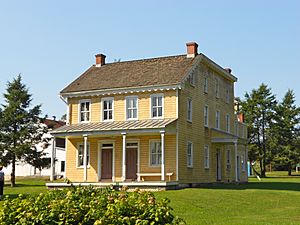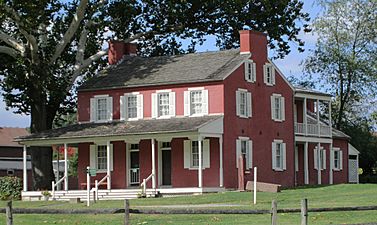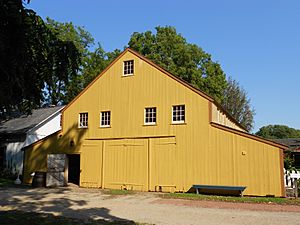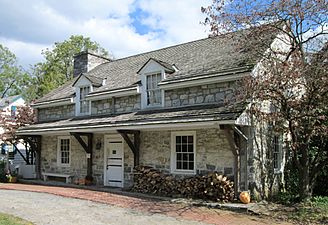Landis Valley Museum facts for kids
|
Landis Valley Village & Farm Museum
|
|
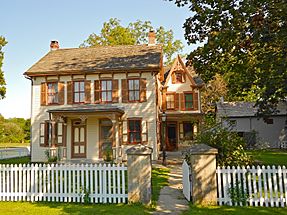
Landis House in September, 2012
|
|
| Nearest city | Lancaster, Pennsylvania |
|---|---|
| Area | 100 acres (40 ha) |
| Built | 1940 |
| Architect | D. L. Warfel & Co. |
| NRHP reference No. | 99001578 |
Quick facts for kids Significant dates |
|
| Added to NRHP | January 3, 2000 |
The Landis Valley Village & Farm Museum is a cool place where you can step back in time! It's a 100-acre living history museum in Lancaster, Pennsylvania. This means it's like a real village from the past, showing how people lived long ago.
The museum was started by two brothers, Henry K. Landis and George Landis, in 1925. It became an official museum in 1941. Today, the Pennsylvania Historical and Museum Commission runs it. Their goal is to collect, save, show, and teach about the history of Pennsylvania German people from 1740 to 1940.
Contents
Discovering History at Landis Valley
The idea for the Landis Valley Village & Farm Museum began in the early 1920s. Two brothers, Henry K. Landis and George Landis, grew up in Lancaster, Pennsylvania. They loved history, especially the history of Pennsylvania German people.
The Landis Brothers' Collection
The brothers became big collectors of old things. They gathered antique furniture, Native American tools, old coins, and even huge Conestoga Wagons. They also collected farm tools, pottery, and beautiful quilts.
After they retired in 1924, the Landis brothers put all their collections together. They opened their family farm in Lancaster to the public in 1925. More and more people came to see their amazing collection.
Becoming an Official Museum
As their collection grew, they looked for help to make it a real museum. In 1941, it officially became the Landis Valley Museum. They even hired a professional to help organize and display everything. New buildings were added, like a barn for farm tools and a gunsmith's shop.
A Living History Experience
In 1953, the Landis brothers gave the museum to the Commonwealth of Pennsylvania. This was a big step! The state bought more land and built historic structures. They wanted to create a "living history" experience.
Now, visitors can see how Pennsylvania Germans lived and worked in the 1700s. Guides dressed in old-fashioned clothes show how people did tasks and made crafts. It's like walking into the past!
Saving Heirloom Seeds
In the mid-1980s, the museum started a special project. They wanted to save heirloom seeds. These are old types of seeds that farmers used before 1940. They grow these seeds at the museum to keep them pure.
The museum has special gardens and greenhouses for this project. They make sure these old plant types don't mix with modern ones. You can even buy some of these special seeds at the museum's Herb & Garden Faire!
Explore the Museum: Exhibits and Events
This living history museum is part of the Pennsylvania State Museum system. It celebrates cool inventions from Lancaster County, Pennsylvania. Did you know the Conestoga wagon and the Pennsylvania longrifle (also called the Kentucky longrifle) were invented here?
Visitors can learn how Conestoga Wagons were built, including their famous spoked wheels. You can also see how gunsmiths made rifle barrels long ago. Guides in period costumes share stories about Pennsylvania German traditions. Artisans show how they made crafts and cooked over open fires.
What You Can See at the Museum
The museum has many different buildings and areas to explore:
- Visitor Center
- Landis House & Stable (shows life from 1870-1890)
- Leatherworking Shop
- Pottery Shop
- Log Farm (shows life from 1760-1780)
- Yellow Barn
- Brick Farmstead (shows life from 1830-1850)
- Erisman House
- Blacksmith Shop
- Tavern
- Transportation Building
- Gun Exhibit
- Landis Valley House Hotel
- Conestoga Wagon Shed
- Maple Grove School
- Farm Implement Shed
- Steam Engine Building
- Textile Processes & Garden
- Country Store
- Isaac Landis House, Barn & Feed Mill
- Firehouse
- Tin Shop
- Landis Valley Museum Store
The museum also hosts fun events throughout the year. One popular event is a free annual bonfire with holiday caroling.
Supporting the Museum
The Landis Valley Village & Farm Museum gets a lot of help from the Landis Valley Associates. This is a group of 3,000 people who support the museum. They volunteer their time and help with money. Members get free museum entry and discounts on special events and at the museum store.
About Henry K. Landis
Henry Kinzer Landis (1865–1955) was a very important person for the museum. He was an editor, photographer, collector, and one of the founders.
Henry's Early Life
Henry was born in Lancaster County, Pennsylvania in 1865. His father, Henry Harrison Landis, was a farmer. Henry had three siblings: George Diller, Nettie May, and Anna Margaretta, who passed away young.
The Landis family had a long history in Pennsylvania. They were Swiss Mennonite people who came to America in 1717 to escape religious persecution. The Landis name is still well-known in Lancaster County today.
Henry grew up on his family's farm. He and his brother George went to Lititz Academy and then to Lehigh University. Henry graduated with a degree in Engineering.
In 1888, Henry took a canoe trip on the Juniata River with his brother George. He kept a diary and took photos of the trip. These were later published in a book called Canoeing on the Juniata, 1888.
Henry's Career and Hobbies
After college, Henry worked as a mining engineer and teacher. He also developed a strong interest in photography.
Later, Henry moved to New York City. He worked as an editor for technical magazines, like The Gas Age, which was about the natural gas industry. On weekends, he loved taking photos around Manhattan and Brooklyn. He also owned a houseboat and a sailing boat in Port Washington.
Henry's photos showed many different things. He photographed New York City architecture, street life, and even took self-portraits.
Retirement and Museum Founding
After many years in New York City, Henry retired. He moved back to the family farm in Lancaster. There, he and his brother George started collecting more and more items. They filled their buildings with old farm tools and household items.
They opened an informal museum, and Henry was the main guide. As their collection grew, they needed more help. A wealthy industrialist named Gustav Oberlaender learned about their collection. His organization, the Oberlaender Trust, helped make the Landis Valley Museum official in 1940. New exhibition buildings were built, and the museum opened in 1941.
Later, the Commonwealth of Pennsylvania took over the museum. It is now run by the Pennsylvania Historical and Museum Commission (PHMC) with help from the Landis Valley Associates. Henry Landis continued to live at the family home and remained a lifetime curator until he passed away in 1955.
Gallery




